Ebola. Just the word by itself instills fear. But in some corners of our shared planet it presents itself as an all too real horror that invades communities, neighborhoods, and families. As this crisis has been unfolding, we at Symplur have been following the same news reports that all of you have with regards to the spread of this disease, the increasing death toll, and concerns of containment.
We’ve also been following Ebola through the unique lens that healthcare social media provides. On July 28, 2014 the current Ebola outbreak hit the mainstream news in the U.S. That morning Symplur began tracking it on Twitter via several hashtags including #Ebola #EbolaOutbreak, #EbolaVirus and #EbolaWatch.
Current trends on the topic of Ebola on social media
For starters, let’s look at some of the basic facts for the 54 days studied from Jul 28 – Sep 19, 2014 …
- 1,787,875 tweets
- 600,910 unique users tweeting
- Most active day had 89,015 tweets (Aug 8, 2014)
During this time, our analysis has uncovered some obvious trends in the social media discussion on Ebola. Most notably, we’ve noticed that Ebola on social media has not mimicked the real-world trend of this virus itself. As the death toll has risen, the public discussion has waned.
Why is that?
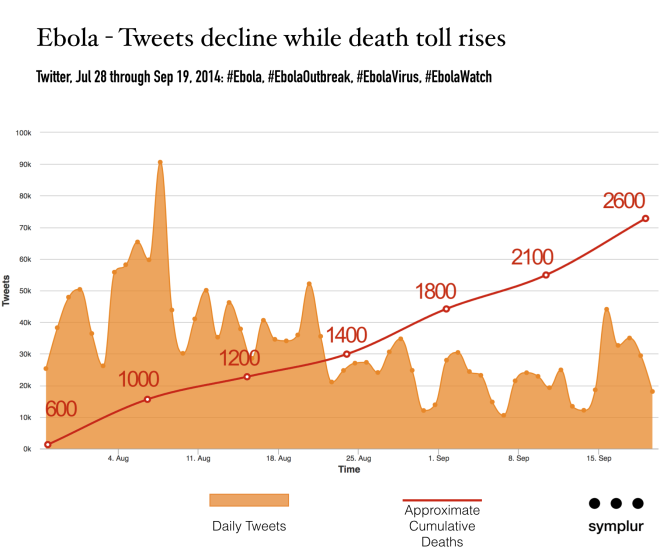 Today’s media includes stories from around the world, but our ability to ingest all these new stories remains limited by both time and sheer brain-power. Consequently, the media itself decides which stories to tell, and even more so which stories to push. A story can be brewing for some time, but until it explodes into a headline the common citizen remains focused on other things.
Today’s media includes stories from around the world, but our ability to ingest all these new stories remains limited by both time and sheer brain-power. Consequently, the media itself decides which stories to tell, and even more so which stories to push. A story can be brewing for some time, but until it explodes into a headline the common citizen remains focused on other things.
We can see how leading news stories have impacted the Ebola discussion on Twitter as each time there was a “new” lead story attached to it there was an obvious spike on that day or the day(s) following.
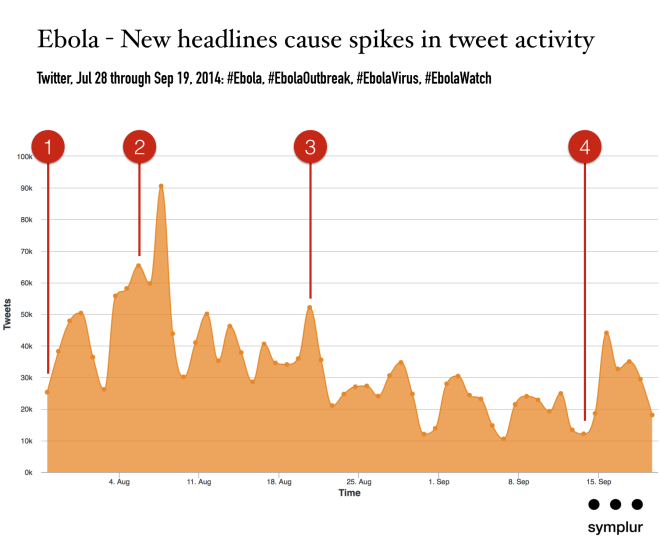
Lead stories (see graph above) …
- July 28, 2014 – Ebola outbreak is the lead story on morning news in U.S.
- August 5, 2014 – Second U.S. Ebola patient arrives at hospital in Atlanta, Georgia.
- August 21, 2014 – First U.S. Ebola patient is discharged from hospital in Atlanta, Georgia.
- September 15, 2014 – President Obama announces that the U.S. is sending up to 3,000 troops to West Africa to assist in responding to Ebola outbreak.
Ebola on social media … a demographic evolution
Most conversations, in both the physical and online worlds, go through an evolution as facts, awareness, and perceived relevance ebbs and flows. Part of this evolution includes changes in who is participating in the conversation itself. With Ebola on Twitter this evolution uncovers some significant details.
For starters, as the Ebola story broke on the U.S. airwaves, we could easily see that residents from the geographic areas afflicted were largely absent on Twitter. It should be noted that tracking location on Twitter has it’s challenges, as only about 1% of tweets are geo-tagged. However, we have several other ways that help us to pinpoint location, and in the period studied we were able to identify location for 50% of the nearly 1.8 million tweets studied. The following is a list of countries that have now had identified cases of Ebola, and how many participants we’ve identified who were involved in the Twitter conversation on that topic during the first two weeks studied.
- Nigeria – 12,192
- Liberia – 240
- Senegal – 225
- Sierra Leone – 147
- Guinea – 87
This shouldn’t surprise us, because even though much of the world is “on the grid”, those areas currently being so actively threatened by Ebola are by-and-large not as privileged as the majority of you who are reading this. Consequently, a social media presence is expected to be slow and minimal in those locations where the outbreak has been occurring.
Over time we can see that the topic of Ebola began to take hold as a global discussion on social media. Below is a heat-map that displays this world wide attention being paid to this story on Twitter. Darker colors represent more participants in the Ebola conversation.
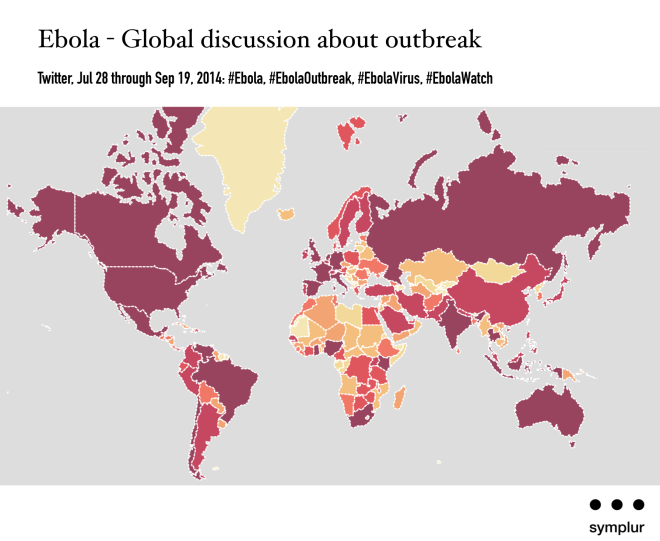
And we can see how that has evolved over time in select countries listed below as we look at the identified number of participants and their locations.
| Country | Jul 28 – Aug 11, 2014 | Jul 28 – Sep 19, 2014 |
| USA | 43,913 | 81,298 |
| Nigeria | 12,192 | 21,221 |
| UK | 9,244 | 20,069 |
| Spain | 6,782 | 13,483 |
| Canada | 5,080 | 10,432 |
| France | 3,773 | 9,790 |
| India | 3,576 | 8,028 |
| South Africa | 3,462 | 8,715 |
| Italy | 3,029 | 6,278 |
| Germany | 2,657 | 6,035 |
| Australia | 2,402 | 5,646 |
| Kenya | 2,147 | 6,215 |
| Brazil | 2,027 | 4,715 |
| Thailand | 1,926 | 4,339 |
| Netherlands | 1,591 | 3,783 |
| Ghana | 1,563 | 2,994 |
| Russia | 1,458 | 3,105 |
| Indonesia | 1,407 | 4,624 |
| Liberia | 240 | 473 |
| Senegal | 225 | 728 |
| Sierra Leone | 147 | 293 |
| Guinea | 87 | 174 |
What’s more, there are 51 primary languages spoken by the participants in the Ebola conversation on Twitter, with English, French, Spanish, Italian and Thai leading the way.
Doctors tweeting about Ebola
We can also see a difference in Twitter activity when comparing doctor participation to that of the general population. Of the the 600,910 unique participants in the Ebola discussion, the average user has tweeted on that topic only 2.98 times. However, U.S. physicians tweeting about Ebola have done so on average 9.37 times. That’s over three times more participation than the average user.
Another positive trend that we can see among doctors tweeting about Ebola is that while the general public’s interest began to wane, as described earlier in this post, U.S. doctors actually accelerated their activity week over week during the same period.
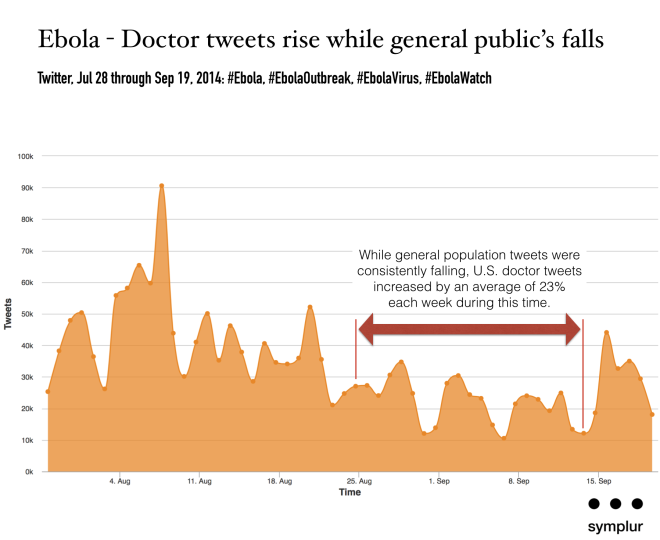
What’s more doctors included links in 68% of their tweets. Their most popular overall source of articles linked to has been The New England Journal of Medicine, but their most popular single link has been to the CDC website’s article on “Infection Prevention and Control Recommendations for Hospitalized Patients with Known or Suspected Ebola Hemorrhagic Fever in U.S. Hospitals”.
And, beyond doctors sharing this CDC article, it has also been widely shared by others and on other platforms as well …
- Total Twitter Shares – 335
- Facebook Likes – 829
- Facebook Shares – 964
- Facebook Comments – 297
- LinkedIn Shares – 213
- Google +1 – 13
It’s also worth noting that when comparing the ten most shared articles by doctors vs. those by the general public that there has been no overlap of links that the two groups are sharing. Is the public missing something here?
Influencing the Twitter discussion on Ebola
So with so much activity and sharing of information, what parties are influencing this discussion the most? Are they trusted sources of good information? Or are they spreading rumor, marginal information, and further panic?
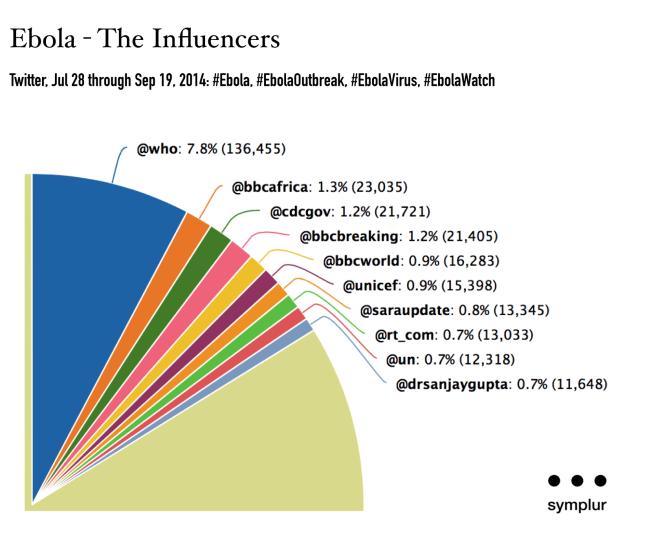
A quick look at the ten participants who are most often mentioned, our preferred measure of influence on Twitter, reveals The World Health Organization (@WHO) at the very top. Also among the influencers are the U.S. Centers for Disease Control and Prevention (@CDCgov), several news outlets, humanitarian organizations, and a well known physician.
So, certainly on the social media front, it seems that at least some of the proper parties are leading the way. It’s reassuring to see The World Health Organization right where we would hope they would be as the foremost voice. And it’s also encouraging, as noted earlier, how some doctors have become active participants and have been sharing their thoughts and insights at an increasing rate.
Here’s hoping that we don’t let our attention wane again on such a serious issue. If we do, the consequences may haunt us.

25 Responses to “Ebola on social media shows some revealing insights”
Ebola on social media reveals some notable insi...
[…] Ebola. Just the word by itself instills fear. But in some corners of our shared planet it presents itself as an all too real horror that invades communit […]
Ebola sur les médias sociaux : Usage et ...
[…] Ebola. Just the word by itself instills fear. But in some corners of our shared planet it presents itself as an all too real horror that invades communit […]
Rosamund Lewis
I agree. Action is long overdue. When will the Government of Canada step up? Our response is an embarrassment.
Thomas M. Lee, B.S., NHA
Hi Dr. Lewis. Thank you so much for visiting this post. My purpose was to provide some insight into what we were seeing on social media related to the ebola outbreak. Our internal analytics provide us with a unique window on how everything from small groups to the global community is reacting to many health topics. With ebola, we were disappointed by the growing apathy … globally. Normally, we keep focused on our role as data-analysts. But Symplur’s sole focus is on healthcare, and oftentimes we can’t help but share our opinion on what we see.
How to be a Powerhouse Content Creator in Healthcare - BrowneKnows
[…] Ebola on social media shows some revealing insights9 SEO Techniques to Dominate the Most Popular Methods of Content DiscoveryPharmaceuticals decry FDA’s social media rulesHootsuite reveals paid social media marketing and e-commerce plansThe death of Google Plus?Ello, Ello? New ‘No Ads’ Social Network Ello […]
Ebola on social media shows some revealing insi...
[…] Ebola. Just the word by itself instills fear. But in some corners of our shared planet it presents itself as an all too real horror that invades communit (RT @StephenMcGann: Great article on social media impact of Ebola […]
Ebola on social media shows some revealing insi...
[…] Ebola. Just the word by itself instills fear. But in some corners of our shared planet it presents itself as an all too real horror that invades communit […]
Ebola on social media shows some revealing insights | Public Health Teaching in Dundee
[…] Source: http://www.symplur.com […]
Ray Lewis
I hope you continue the analysis of Ebola coverage on twitter after the first US case was diagnosed in Texas. Someone should compare to other information sources for accuracy and usefulness.
Thomas M. Lee, B.S., NHA
Hi Ray. We’ll be posting more on the social media response to Ebola shortly. And yes, activity indeed spiked once the public realized that this disease can, and has, spread from West Africa. We invite collaboration with other health related research, and have been a supportive resource in many studies … http://www.symplur.com/healthcare-social-media-research/
Ebola on social media shows some revealing insi...
[…] Ebola. Just the word by itself instills fear. But in some corners of our shared planet it presents itself as an all too real horror that invades communities, neighborhoods, and families. As this crisis has been unfolding, we at Symplur have been following the same news reports that all of you have with regards to the spread of this disease, the increasing death toll, and concerns of containment.We’ve also been following Ebola through the unique lens that healthcare social media provides. On July 28, 2014 the current Ebola outbreak hit the mainstream news in the U.S. That morning Symplur began tracking it on Twitter via several hashtags including #Ebola #EbolaOutbreak, #EbolaVirus and #EbolaWatch. […]
Prof
Thanks for your work. Some very interesting revelations in your data here. Will be interesting to see what happens after Sept 15.
Thomas M. Lee, B.S., NHA
Hi Dr. Fuller. As you know, much has happened since this post was published. And the social media reaction to these news events has been huge. I’ll be posting more shortly. Thank you so much for the incredibly informative tweet chat on Oct 2nd (#NSTNSchat). I was a fortunate participant, enjoyed it, and learned so much! A great group of people too.
You can’t fight Ebola with drones! | Social Media for Good
[…] will only reach a fraction of the people – and hardly anyone in rural areas. Not surprisingly, a recent look at how and where Ebola is being discussed on social media showed that the affected countries are at […]
Ebola on social media shows some revealing insi...
[…] Ebola. Just the word by itself instills fear. But in some corners of our shared planet it presents itself as an all too real horror that invades communities, neighborhoods, and families. As this crisis has been unfolding, we at Symplur have been following the same news reports that all of you have with regards to the spread of this disease, the increasing death toll, and concerns of containment.We’ve also been following Ebola through the unique lens that healthcare social media provides. On July 28, 2014 the current Ebola outbreak hit the mainstream news in the U.S. That morning Symplur began tracking it on Twitter via several hashtags including #Ebola #EbolaOutbreak, #EbolaVirus and #EbolaWatch.Current trends on the topic of Ebola on social mediaFor starters, let’s look at some of the basic facts for the 54 days studied from Jul 28 – Sep 19, 2014 …1,787,875 tweets600,910 unique users tweetingMost active day had 89,015 tweets (Aug 8, 2014)During this time, our analysis has uncovered some obvious trends in the social media discussion on Ebola. Most notably, we’ve noticed that Ebola on social media has not mimicked the real-world trend of this virus itself. As the death toll has risen, the public discussion has waned.Why is that?Today’s media includes stories from around the world, but our ability to ingest all these new stories remains limited by both time and sheer brain-power. Consequently, the media itself decides which stories to tell, and even more so which stories to push. A story can be brewing for some time, but until it explodes into a headline the common citizen remains focused on other things.We can see how leading news stories have impacted the Ebola discussion on Twitter as each time there was a “new” lead story attached to it there was an obvious spike on that day or the day(s) following. Lead stories (see graph above) …July 28, 2014 – Ebola outbreak is the lead story on morning news in U.S.August 5, 2014 – Second U.S. Ebola patient arrives at hospital in Atlanta, Georgia.August 21, 2014 – First U.S. Ebola patient is discharged from hospital in Atlanta, Georgia.September 15, 2014 – President Obama announces that the U.S. is sending up to 3,000 troops to West Africa to assist in responding to Ebola outbreak.Ebola on social media … a demographic evolutionMost conversations, in both the physical and online worlds, go through an evolution as facts, awareness, and perceived relevance ebbs and flows. Part of this evolution includes changes in who is participating in the conversation itself. With Ebola on Twitter this evolution uncovers some significant details.For starters, as the Ebola story broke on the U.S. airwaves, we could easily see that residents from the geographic areas afflicted were largely absent on Twitter. It should be noted that tracking location on Twitter has it’s challenges, as only about 1% of tweets are geo-tagged. However, we have several other ways that help us to pinpoint location, and in the period studied we were able to identify location for 50% of the nearly 1.8 million tweets studied. The following is a list of countries that have now had identified cases of Ebola, and how many participants we’ve identified who were involved in the Twitter conversation on that topic during the first two weeks studied.Nigeria – 12,192Liberia – 240Senegal – 225Sierra Leone – 147Guinea – 87This shouldn’t surprise us, because even though much of the world is “on the grid”, those areas currently being so actively threatened by Ebola are by-and-large not as privileged as the majority of you who are reading this. Consequently, a social media presence is expected to be slow and minimal in those locations where the outbreak has been occurring.Over time we can see that the topic of Ebola began to take hold as a global discussion on social media. Below is a heat-map that displays this world wide attention being paid to this story on Twitter. Darker colors represent more participants in the Ebola conversation. And we can see how that has evolved over time in select countries listed below as we look at the identified number of participants and their locations.CountryJul 28 – Aug 11, 2014Jul 28 – Sep 19, 2014USA43,91381,298Nigeria12,19221,221UK9,24420,069Spain6,78213,483Canada5,08010,432France3,7739,790India3,5768,028South Africa3,4628,715Italy3,0296,278Germany2,6576,035Australia2,4025,646Kenya2,1476,215Brazil2,0274,715Thailand1,9264,339Netherlands1,5913,783Ghana1,5632,994Russia1,4583,105Indonesia1,4074,624Liberia240473Senegal225728Sierra Leone147293Guinea87174 What’s more, there are 51 primary languages spoken by the participants in the Ebola conversation on Twitter, with English, French, Spanish, Italian and Thai leading the way.Doctors tweeting about EbolaWe can also see a difference in Twitter activity when comparing doctor participation to that of the general population. Of the the 600,910 unique participants in the Ebola discussion, the average user has tweeted on that topic only 2.98 times. However, U.S. physicians tweeting about Ebola have done so on average 9.37 times. That’s over three times more participation than the average user.Another positive trend that we can see among doctors tweeting about Ebola is that while the general public’s interest began to wane, as described earlier in this post, U.S. doctors actually accelerated their activity week over week during the same period. What’s more doctors included links in 68% of their tweets. Their most popular overall source of articles linked to has been The New England Journal of Medicine, but their most popular single link has been to the CDC website’s article on “Infection Prevention and Control Recommendations for Hospitalized Patients with Known or Suspected Ebola Hemorrhagic Fever in U.S. Hospitals”.And, beyond doctors sharing this CDC article, it has also been widely shared by others and on other platforms as well …Total Twitter Shares – 335Facebook Likes – 829Facebook Shares – 964Facebook Comments – 297LinkedIn Shares – 213Google +1 – 13It’s also worth noting that when comparing the ten most shared articles by doctors vs. those by the general public that there has been no overlap of links that the two groups are sharing. Is the public missing something here?Influencing the Twitter discussion on EbolaSo with so much activity and sharing of information, what parties are influencing this discussion the most? Are they trusted sources of good information? Or are they spreading rumor, marginal information, and further panic? A quick look at the ten participants who are most often mentioned, our preferred measure of influence on Twitter, reveals The World Health Organization (@WHO) at the very top. Also among the influencers are the U.S. Centers for Disease Control and Prevention (@CDCgov), several news outlets, humanitarian organizations, and a well known physician.So, certainly on the social media front, it seems that at least some of the proper parties are leading the way. It’s reassuring to see The World Health Organization right where we would hope they would be as the foremost voice. And it’s also encouraging, as noted earlier, how some doctors have become active participants and have been sharing their thoughts and insights at an increasing rate.Here’s hoping that we don’t let our attention wane again on such a serious issue. If we do, the consequences may haunt us. […]
CDC, Ebola & Tweet Chats: was this venue a success?
[…] our previous post we discussed how Ebola had been emerging as a topic of discussion on social media, and how the conversation was actually dwindling as the number of lives being claimed by the virus […]
Ebola on social media | Salud Conectada | Scoo...
[…] Ebola. Just the word by itself instills fear. But in some corners of our shared planet it presents itself as an all too real horror that invades communities, neighborhoods, and families. As this crisis has been unfolding, we at Symplur have been following the same news reports that all of you have with regards to the spread of this disease, the increasing death toll, and concerns of containment. […]
Ebola on social media | Salud Publica | Scoop.it
[…] Ebola. Just the word by itself instills fear. But in some corners of our shared planet it presents itself as an all too real horror that invades communities, neighborhoods, and families. As this crisis has been unfolding, we at Symplur have been following the same news reports that all of you have with regards to the spread of this disease, the increasing death toll, and concerns of containment. […]
Brian Yoshio Laing, MD, MPH
I’ve noticed something troubling on Facebook — hardly anyone seems to respond to posts about Ebola or donating to groups like Doctors Without Borders. On the other hand, if I post some trivial, funny picture, folks seems to “like” it very quickly. I suppose it’s not surprising but it’s hard not to feel a bit disappointed.
Thomas M. Lee, B.S., NHA
Thank you for your comment, Dr Laing. You’re right, it is disappointing. I think it was obvious that, at least in the US, ebola seemed like a far-away issue that didn’t directly affect us. As such the population, while aware, were detached. The Twitter conversation has grown about 15-fold since Mr. Duncan was diagnosed in Dallas, so there’s at least more attention now. Deutsche Welle just ran a story that speaks somewhat to your point. It’s titled, “Is increased media attention on Ebola translating into more donations?” Check it out here: http://www.dw.de/is-increased-media-attention-on-ebola-translating-into-more-donations/a-17995803
Ebola and the viral spread of information - Body in Mind
[…] [1] Symplur: Ebola on social media shows some revealing insights […]
Watching Ebola Conversations | Beyond Digital Strategy
[…] [1] Symplur: Ebola on social media shows some revealing insights […]
Como jornalistas usaram as redes sociais para cobrir os maiores eventos de 2014
[…] Mundial de Saúde, a BBC África foi um influenciador importante no Twitter sobre ebola, segundo dados do Symplur, um analisador de mídia social sobre saúde. A BBC também lançou um serviço […]
Check out these links! | loginwithlauren
[…] Ebola on social media shows some revealing insights […]
Uses and Misuses of Social Media | anetwesonga
[…] addition to public health sites like WHO, BBC Africa was a strong Twitter influencer on Ebola, according to data from health care social media analyzer Symplur. The BBC also launched an Ebola public […]